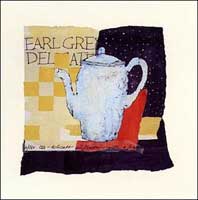|
|
Of Tea I Sing
by Marjorie Dorfman
|
Russian interest in tea began in 1615 when the Chinese Embassy in Moscow presented several chests of tea to Czar Alexis. By the late 1700's tea was spreading throughout Russian society. The samovar became a popular dispenser, as a combination hot water heater and teapot. Placed in the center of the Russian home, it could run all day and serve up to forty cups of tea at one time. Tea (along with vodka) is the national drink of Russia today.
You can buy this Art print
at AllPosters.com

Earl Grey
by A. Pearce
9 in x 9 in
|
Tea is made from the leaves of the Camellia Senesis tree. Tea growers prune their bushes, not only to keep them short enough to work with, but also to force the plant to produce repeated flushes of tiny, tender new leaves. Once the tender young leaves are plucked, they must be processed. There are three basic methods used, each producing one of the standard tea types: black, green or oolong. These terms do not refer to the types of tea leaves but rather to the process.
Black tea is by far the most common. Over 90 percent of the tea consumed in the United States is black tea. The leaves are steamed, rolled (to crack and release the juices), permitted to age and then fired (thus dried). The aging process ferments the tannin oils and adds to the body and base of the hearty flavored amber brew. The British Isles are the largest importers of tea and most of it is black. The traditional English breakfast tea (which blends well with milk) hails from the Keemum region of China; the traditional Irish is a blend from India and Ceylon. Some of the most popular ones include: English Breakfast, Darjeeling (a Himalayan blend with a subtly lingering aroma reminiscent of Muscatel that is also known as the champagne of teas), Earl Grey (a smoky tea with a hint of sweetness to it) and Orange Pekoe (a blend of Ceylon teas that is the most widely used of the tea blends). At the other end of the spectrum are green teas which make up only 10% of the world's production. These leaves are steamed and rolled, same as the black, but skip the oxidizing step. They are immediately fired (without severance pay or references) to prevent aging and fermentation. There's more of an herbal, fruity taste to green tea because it is closer to the natural leaf. It is more pungent than its black counterpart because the tannin oils are left intact in the process. A great many people prefer the delicate taste, finding it more interesting than the more aged and mellow black. Green tea is the drinker's choice in Japan, which is also the world's largest producer of this type. It has gained popularity in the United States due in part to recent scientific studies linking it with reduced cancer risk.
For oolong tea, the leaves are steamed, rolled and then aged, but the fermentation is cut short. The leaves are fired before they reach the full black stage. Hence, the name of this tea from the Chinese word wu lung or black dragon (black tea with a bite!) It is a cross between black and green tea in color and taste with a flavor that is not raw or bitter with a trace of fruit and herbs. Oolong is popular in China and is sometimes known as the burgundy of teas. The highest grade oolongs are grown in Taiwan where it is not only a preferred selection, but is also a source of national pride.
 All in all, there is much more than meets the eye within the vast world of tea. It is a drink steeped (forgive the pun) in history and, as such, worthy of respect. So even if the amber liquid is not your particular cup of tea, the next time you serve some to your guests or sample a cup yourself, remember that your actions may have repercussions more severe than any waxy floor build-up. You may well influence the opinions of political leaders, enhance the wealth of an empire and find yourself responsible for the unfortunate demise of a single teabag. As far as the future is concerned, we must all brace ourselves and be prepared for the ultimate possibility of tea for two with or without sympathy.
All in all, there is much more than meets the eye within the vast world of tea. It is a drink steeped (forgive the pun) in history and, as such, worthy of respect. So even if the amber liquid is not your particular cup of tea, the next time you serve some to your guests or sample a cup yourself, remember that your actions may have repercussions more severe than any waxy floor build-up. You may well influence the opinions of political leaders, enhance the wealth of an empire and find yourself responsible for the unfortunate demise of a single teabag. As far as the future is concerned, we must all brace ourselves and be prepared for the ultimate possibility of tea for two with or without sympathy.
Did you know . . .
Check this review by Marjorie of an interesting kitchen gadget:
When you simply can’t wait a moment more for that water to boil!
The Electric Kettle
|
|
|
|
 |
|